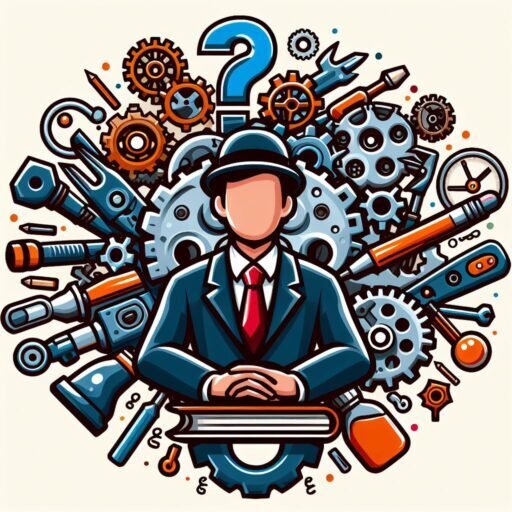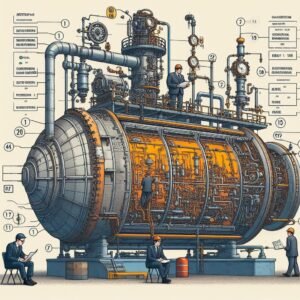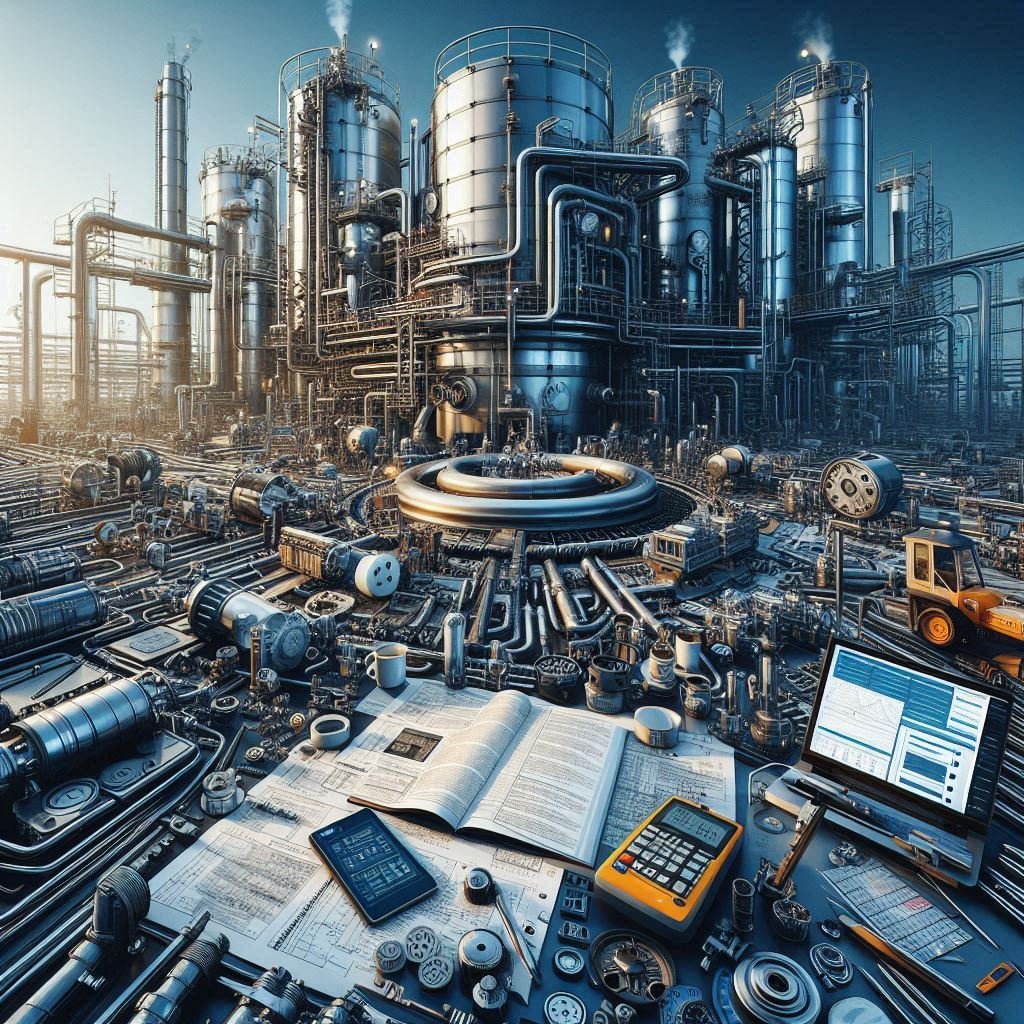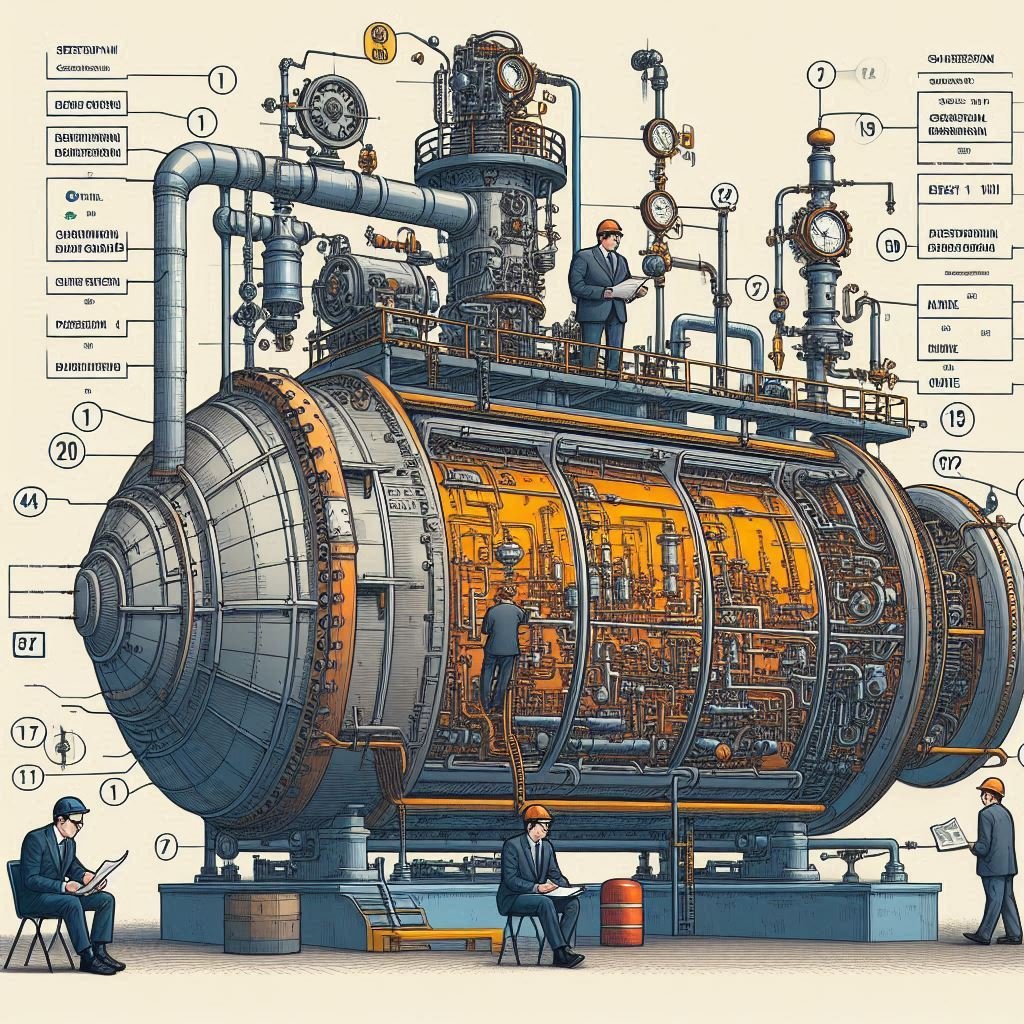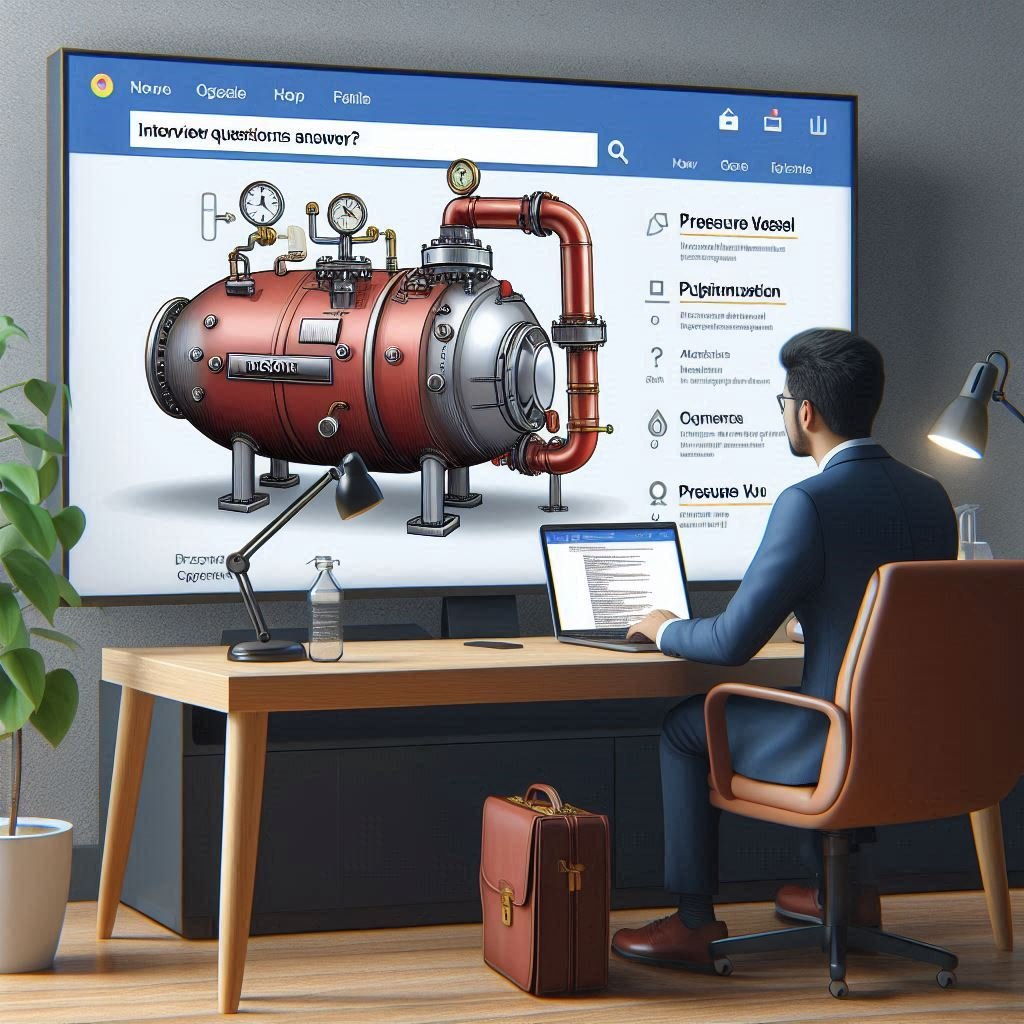
Got Call for Job of Junior Mechanical Engineer?
Searching for Interview questions Ends Here
Read It !!!! Crack It !!!!
Junior Mechanical Engineer – Stepping into the World of Mechanical Engineering
Introduction to Junior Mechanical Engineer Job Designation:
A Junior Mechanical Engineer plays a crucial role in the engineering team by assisting senior engineers in designing, testing, and analysing mechanical systems and components. This entry-level position is an excellent opportunity for recent graduates or those new to the field to gain hands-on experience and develop their technical skills in a supportive environment.
As a Junior Mechanical Engineer, your primary responsibility is to support the design and development of mechanical systems. This involves creating detailed drawings and specifications using CAD software, performing calculations and simulations to ensure designs meet performance and safety standards, and assisting in the prototyping and testing phases. You will collaborate closely with senior engineers, leveraging their expertise to refine your designs and troubleshoot any issues that arise.
In addition to design work, a Junior Mechanical Engineer is often involved in the testing and analysis of mechanical components. This includes setting up and conducting experiments, collecting and interpreting data, and preparing detailed reports on your findings. Your analytical skills will be put to the test as you identify potential improvements and contribute to the optimization of existing systems.
Effective communication and teamwork are essential in this role. You will need to clearly convey your ideas and findings to colleagues and stakeholders, often presenting your work in meetings and collaborating on cross-functional projects. Attention to detail and a commitment to continuous learning are also vital, as the field of mechanical engineering is constantly evolving with new technologies and methodologies.
Overall, the role of a Junior Mechanical Engineer is both challenging and rewarding, offering a solid foundation for a successful career in mechanical engineering. By gaining hands-on experience and developing your technical skills, you will be well-equipped to tackle more complex projects and advance within the field. This position not only hones your engineering abilities but also fosters professional growth through mentorship and practical application of engineering principles.
Now lets jump to the important aspect of Interview Questions and its answers can be put forth to you during interview for Post of Junior Mechanical Engineer. Following are the general and mostly asked questions and answers for post of Junior Mechanical Engineer. So Lets Start:
General Questions and Answer to Junior Mechanical Engineer:
- Tell us about your educational background and any relevant projects you have worked on.
- Answer: I have a Bachelor’s degree in Mechanical Engineering from XYZ University. Then describe the projects you have taken care of during your industrial training or as a part of the your education. Make sure you know every detail of the Industrial projects you have taken during your education.
- Answer: I have a Bachelor’s degree in Mechanical Engineering from XYZ University. Then describe the projects you have taken care of during your industrial training or as a part of the your education. Make sure you know every detail of the Industrial projects you have taken during your education.
- Why did you choose mechanical engineering as your career?
- Answer: I chose mechanical engineering because I have always been fascinated by how things work and enjoy solving complex problems. Mechanical engineering offers a diverse range of opportunities and the chance to work on innovative projects.
- Answer: I chose mechanical engineering because I have always been fascinated by how things work and enjoy solving complex problems. Mechanical engineering offers a diverse range of opportunities and the chance to work on innovative projects.
- What interests you most about this position?
- Answer: I am particularly interested in this position because it offers the opportunity to work closely with experienced engineers, which will help me enhance my skills in designing, testing, and analyzing mechanical systems. Additionally, I am eager to contribute to challenging projects.
- Answer: I am particularly interested in this position because it offers the opportunity to work closely with experienced engineers, which will help me enhance my skills in designing, testing, and analyzing mechanical systems. Additionally, I am eager to contribute to challenging projects.
- What are your long-term career goals as a mechanical engineer?
- Answer: My long-term career goal is to become a lead mechanical engineer, overseeing major projects and contributing to innovative designs. I aim to gain experience in various aspects of mechanical engineering, including project management and advanced simulation techniques.
- Answer: My long-term career goal is to become a lead mechanical engineer, overseeing major projects and contributing to innovative designs. I aim to gain experience in various aspects of mechanical engineering, including project management and advanced simulation techniques.
- Can you describe a challenging project you worked on and how you overcame the challenges?
- Answer: One challenging project was designing a cooling system for an electronic device. The main challenge was ensuring efficient heat dissipation within limited space constraints. I overcame this by conducting detailed thermal analysis using simulation tools and optimizing the design for maximum efficiency.
- Answer: One challenging project was designing a cooling system for an electronic device. The main challenge was ensuring efficient heat dissipation within limited space constraints. I overcame this by conducting detailed thermal analysis using simulation tools and optimizing the design for maximum efficiency.
Technical Knowledge and Skills Junior Mechanical Engineer:
- Explain the difference between stress and strain.
- Answer: Stress is the internal force per unit area within a material that arises from externally applied forces. Strain is the deformation or displacement of a material that results from an applied stress. Stress measures the intensity of internal forces, while strain measures the extent of deformation.
- Answer: Stress is the internal force per unit area within a material that arises from externally applied forces. Strain is the deformation or displacement of a material that results from an applied stress. Stress measures the intensity of internal forces, while strain measures the extent of deformation.
- What is the principle of conservation of energy?
- Answer: The principle of conservation of energy states that energy cannot be created or destroyed, only transformed from one form to another. In a mechanical system, this means the total energy (kinetic, potential, thermal, etc.) remains constant unless acted upon by external forces.
- Answer: The principle of conservation of energy states that energy cannot be created or destroyed, only transformed from one form to another. In a mechanical system, this means the total energy (kinetic, potential, thermal, etc.) remains constant unless acted upon by external forces.
- Describe the laws of thermodynamics.
- Answer:
- First Law: Energy cannot be created or destroyed, only converted from one form to another (conservation of energy).
- Second Law: In any energy transfer or transformation, the total entropy of a system and its surroundings always increases.
- Third Law: As the temperature of a system approaches absolute zero, the entropy of a perfect crystal approaches a constant minimum.
- First Law: Energy cannot be created or destroyed, only converted from one form to another (conservation of energy).
- Answer:
- What is the difference between heat transfer by conduction, convection, and radiation?
- Answer:
- Conduction: Transfer of heat through a solid material due to direct molecular interaction.
- Convection: Transfer of heat by the physical movement of a fluid (liquid or gas).
- Radiation: Transfer of heat in the form of electromagnetic waves, which can occur in a vacuum.
- Conduction: Transfer of heat through a solid material due to direct molecular interaction.
- Answer:
- How do you calculate the efficiency of a mechanical system?
- Answer: Efficiency is calculated as the ratio of useful output energy to input energy, often expressed as a percentage: Efficiency (%) = (Useful Output Energy / Input Energy) * 100.
- Answer: Efficiency is calculated as the ratio of useful output energy to input energy, often expressed as a percentage: Efficiency (%) = (Useful Output Energy / Input Energy) * 100.
Mechanical Design and Analysis Junior Mechanical Engineer:
- What is CAD, and which software are you proficient in?
- Answer: CAD stands for Computer-Aided Design. It is used for creating precise drawings and technical illustrations. I am proficient in software such as AutoCAD, SolidWorks, and CATIA.
- Answer: CAD stands for Computer-Aided Design. It is used for creating precise drawings and technical illustrations. I am proficient in software such as AutoCAD, SolidWorks, and CATIA.
- How do you approach the design process for a new component?
- Answer: The design process typically involves identifying the problem, brainstorming solutions, creating preliminary sketches, selecting materials, developing detailed CAD models, and iterating based on analysis and feedback.
- Answer: The design process typically involves identifying the problem, brainstorming solutions, creating preliminary sketches, selecting materials, developing detailed CAD models, and iterating based on analysis and feedback.
- Explain the concept of Finite Element Analysis (FEA).
- Answer: FEA is a computational method used to predict how a product reacts to real-world forces, vibration, heat, and other physical effects. It divides the model into finite elements, solving for various physical behaviors.
- Answer: FEA is a computational method used to predict how a product reacts to real-world forces, vibration, heat, and other physical effects. It divides the model into finite elements, solving for various physical behaviors.
- What factors do you consider when selecting materials for a design?
- Answer: Factors include mechanical properties (strength, ductility), thermal properties, corrosion resistance, cost, manufacturability, and environmental impact.
- Answer: Factors include mechanical properties (strength, ductility), thermal properties, corrosion resistance, cost, manufacturability, and environmental impact.
- Describe a situation where you used simulation tools for design analysis.
- Answer: I used SolidWorks Simulation to analyze the stress distribution on a bracket under load. This helped identify weak points and optimize the design for better performance and durability.
- Answer: I used SolidWorks Simulation to analyze the stress distribution on a bracket under load. This helped identify weak points and optimize the design for better performance and durability.
Practical Application and Problem-Solving Junior Mechanical Engineer:
- Can you describe a time when you identified and solved a mechanical problem?
- Answer: In a university project, I identified that a gearbox was overheating due to poor lubrication. I redesigned the lubrication system, which resolved the issue and improved the gearbox’s efficiency.
- Answer: In a university project, I identified that a gearbox was overheating due to poor lubrication. I redesigned the lubrication system, which resolved the issue and improved the gearbox’s efficiency.
- What steps would you take to troubleshoot a malfunctioning machine?
- Answer: I would start with a visual inspection, check for obvious signs of wear or damage, review the machine’s maintenance logs, perform diagnostic tests, and systematically check each component to isolate the problem.
- Answer: I would start with a visual inspection, check for obvious signs of wear or damage, review the machine’s maintenance logs, perform diagnostic tests, and systematically check each component to isolate the problem.
- Explain the concept of mechanical advantage and provide an example.
- Answer: Mechanical advantage is the ratio of output force to input force in a machine. For example, in a lever, the mechanical advantage is achieved by positioning the fulcrum closer to the load, allowing a smaller input force to lift a heavier load.
- Answer: Mechanical advantage is the ratio of output force to input force in a machine. For example, in a lever, the mechanical advantage is achieved by positioning the fulcrum closer to the load, allowing a smaller input force to lift a heavier load.
- How do you ensure your designs are manufacturable?
- Answer: I consider manufacturing processes early in the design phase, collaborate with manufacturing experts, simplify designs to reduce complexity, and use standard components when possible.
- Answer: I consider manufacturing processes early in the design phase, collaborate with manufacturing experts, simplify designs to reduce complexity, and use standard components when possible.
- What are some common mechanical failures and their causes?
- Answer: Common failures include fatigue (due to repetitive loading), corrosion (due to chemical reactions), wear (due to friction), and thermal failure (due to excessive heat).
- Answer: Common failures include fatigue (due to repetitive loading), corrosion (due to chemical reactions), wear (due to friction), and thermal failure (due to excessive heat).
Testing and Quality Control Junior Mechanical Engineer:
- What methods do you use for testing mechanical systems?
- Answer: Methods include static and dynamic load testing, vibration analysis, thermal analysis, and non-destructive testing techniques like ultrasound or X-ray.
- Answer: Methods include static and dynamic load testing, vibration analysis, thermal analysis, and non-destructive testing techniques like ultrasound or X-ray.
- Describe a time when you conducted a test and the results led to a design change.
- Answer: I conducted a vibration test on a pump assembly and found excessive vibrations. This led to redesigning the mounting system to include better damping materials, which reduced the vibrations significantly.
- Answer: I conducted a vibration test on a pump assembly and found excessive vibrations. This led to redesigning the mounting system to include better damping materials, which reduced the vibrations significantly.
- How do you ensure the quality and reliability of your designs?
- Answer: By conducting thorough analysis and simulations, performing rigorous testing, adhering to industry standards, and continuously reviewing and refining the design based on feedback.
- Answer: By conducting thorough analysis and simulations, performing rigorous testing, adhering to industry standards, and continuously reviewing and refining the design based on feedback.
- What is the importance of tolerance and fit in mechanical design?
- Answer: Tolerance and fit are crucial for ensuring that parts assemble correctly and function as intended. Proper tolerances prevent issues like excessive wear, misalignment, and mechanical failure.
- Answer: Tolerance and fit are crucial for ensuring that parts assemble correctly and function as intended. Proper tolerances prevent issues like excessive wear, misalignment, and mechanical failure.
- Explain the role of non-destructive testing (NDT) in quality control.
- Answer: NDT methods allow the inspection and evaluation of materials and components without causing damage. This is essential for detecting flaws and ensuring the integrity of parts during and after manufacturing.
- Answer: NDT methods allow the inspection and evaluation of materials and components without causing damage. This is essential for detecting flaws and ensuring the integrity of parts during and after manufacturing.
Project Management and Collaboration Junior Mechanical Engineer:
- How do you prioritize tasks when working on multiple projects?
- Answer: I prioritize tasks based on deadlines, project importance, resource availability, and dependencies. I use project management tools and create detailed schedules to stay organized.
- Answer: I prioritize tasks based on deadlines, project importance, resource availability, and dependencies. I use project management tools and create detailed schedules to stay organized.
- Describe your experience working as part of a team.
- Answer: I have worked in various team settings during my academic projects and internships. I find effective communication and collaboration essential for success, and I always strive to contribute positively to the team’s goals.
- Answer: I have worked in various team settings during my academic projects and internships. I find effective communication and collaboration essential for success, and I always strive to contribute positively to the team’s goals.
- How do you handle conflicts within a project team?
- Answer: I address conflicts by first understanding the perspectives of all parties involved, facilitating open and respectful communication, and working together to find a mutually acceptable solution.
- Answer: I address conflicts by first understanding the perspectives of all parties involved, facilitating open and respectful communication, and working together to find a mutually acceptable solution.
- What project management tools are you familiar with?
- Answer: I am familiar with tools like Microsoft Project, Trello, and Asana for managing tasks, timelines, and team collaboration.
- Answer: I am familiar with tools like Microsoft Project, Trello, and Asana for managing tasks, timelines, and team collaboration.
- How do you communicate technical information to non-engineers?
- Answer: I use simple language, visual aids, and analogies to explain technical concepts. I also focus on the practical implications and benefits to make the information more relatable.
- Answer: I use simple language, visual aids, and analogies to explain technical concepts. I also focus on the practical implications and benefits to make the information more relatable.
Innovation and Continuous Learning Junior Mechanical Engineer:
- How do you stay updated with the latest advancements in mechanical engineering?
- Answer: I regularly read industry journals, attend webinars and conferences, participate in professional organizations, and take online courses to keep my knowledge current.
- Answer: I regularly read industry journals, attend webinars and conferences, participate in professional organizations, and take online courses to keep my knowledge current.
- Can you describe a time when you implemented a new technology or method in your work?
- Answer: During an internship, I introduced a new 3D printing technique to create prototypes faster and at a lower cost. This significantly improved the development timeline and allowed for more iterative testing.
- Answer: During an internship, I introduced a new 3D printing technique to create prototypes faster and at a lower cost. This significantly improved the development timeline and allowed for more iterative testing.
- What role does creativity play in engineering design?
- Answer: Creativity is essential for finding innovative solutions to engineering problems, improving existing designs, and thinking outside the box to develop new products and technologies.
- Answer: Creativity is essential for finding innovative solutions to engineering problems, improving existing designs, and thinking outside the box to develop new products and technologies.
- How do you approach learning a new software tool or technology?
- Answer: I start with online tutorials and documentation, practice by working on small projects, and seek guidance from experienced colleagues or online forums to deepen my understanding.
- Answer: I start with online tutorials and documentation, practice by working on small projects, and seek guidance from experienced colleagues or online forums to deepen my understanding.
- What professional organizations or networks are you a part of?
- Answer: I am a member of the American Society of Mechanical Engineers (ASME) and participate in local engineering meetups to network and stay informed about industry trends.
- Answer: I am a member of the American Society of Mechanical Engineers (ASME) and participate in local engineering meetups to network and stay informed about industry trends.
Safety and Compliance Junior Mechanical Engineer:
- What safety considerations do you take into account when designing mechanical systems?
- Answer: I consider factors like load limits, material properties, environmental conditions, user safety, and potential failure modes. I also ensure compliance with relevant safety standards and regulations.
- Answer: I consider factors like load limits, material properties, environmental conditions, user safety, and potential failure modes. I also ensure compliance with relevant safety standards and regulations.
- How do you ensure compliance with industry standards and regulations?
- Answer: I stay updated on the latest standards and regulations, incorporate them into my design process, and conduct regular reviews and audits to ensure adherence.
- Answer: I stay updated on the latest standards and regulations, incorporate them into my design process, and conduct regular reviews and audits to ensure adherence.
- Describe a time when you identified a potential safety hazard and how you addressed it.
- Answer: During a project, I noticed a machine lacked proper guarding, posing a risk of injury. I proposed and implemented additional safety guards, and updated the operating procedures to include proper usage guidelines.
- Answer: During a project, I noticed a machine lacked proper guarding, posing a risk of injury. I proposed and implemented additional safety guards, and updated the operating procedures to include proper usage guidelines.
- What personal protective equipment (PPE) do you consider essential for mechanical engineers?
- Answer: Essential PPE includes safety glasses, gloves, ear protection, steel-toed boots, and appropriate clothing to protect against hazards like flying debris, noise, and heavy objects.
- Answer: Essential PPE includes safety glasses, gloves, ear protection, steel-toed boots, and appropriate clothing to protect against hazards like flying debris, noise, and heavy objects.
- How do you perform a risk assessment for a mechanical project?
- Answer: I identify potential hazards, evaluate the risks associated with each hazard, determine the likelihood and impact of these risks, and implement measures to mitigate or eliminate them.
- Answer: I identify potential hazards, evaluate the risks associated with each hazard, determine the likelihood and impact of these risks, and implement measures to mitigate or eliminate them.
Practical Examples and Scenarios Junior Mechanical Engineer:
- Explain how you would design a simple gear system.
- Answer: I would start by defining the requirements (e.g., speed, torque), select the appropriate gear type (spur, helical), calculate the gear ratios, design the gear dimensions using CAD software, and perform stress analysis to ensure durability.
- Answer: I would start by defining the requirements (e.g., speed, torque), select the appropriate gear type (spur, helical), calculate the gear ratios, design the gear dimensions using CAD software, and perform stress analysis to ensure durability.
- Describe the process of creating a prototype from a CAD model.
- Answer: The process involves finalizing the CAD design, exporting the model to a compatible file format for the prototyping method (e.g., 3D printing), fabricating the prototype, and then testing and evaluating it for design improvements.
- Answer: The process involves finalizing the CAD design, exporting the model to a compatible file format for the prototyping method (e.g., 3D printing), fabricating the prototype, and then testing and evaluating it for design improvements.
- What are the steps involved in conducting a thermal analysis of a component?
- Answer: Steps include defining the thermal boundary conditions, selecting the appropriate analysis method (analytical or numerical), creating a thermal model, running simulations, and interpreting the results to optimize the design.
- Answer: Steps include defining the thermal boundary conditions, selecting the appropriate analysis method (analytical or numerical), creating a thermal model, running simulations, and interpreting the results to optimize the design.
- How would you approach designing a heat exchanger?
- Answer: I would determine the required heat transfer rate, select the type of heat exchanger, calculate the surface area needed for heat transfer, choose suitable materials, and create a detailed design using CAD software.
- Answer: I would determine the required heat transfer rate, select the type of heat exchanger, calculate the surface area needed for heat transfer, choose suitable materials, and create a detailed design using CAD software.
- Describe the process of conducting a failure mode and effects analysis (FMEA).
- Answer: FMEA involves identifying potential failure modes, determining their causes and effects, evaluating the risk associated with each failure mode, prioritizing them based on severity, and implementing corrective actions to mitigate risks.
- Answer: FMEA involves identifying potential failure modes, determining their causes and effects, evaluating the risk associated with each failure mode, prioritizing them based on severity, and implementing corrective actions to mitigate risks.
Behavioral and Situational Questions Junior Mechanical Engineer:
- How do you handle tight deadlines and pressure?
- Answer: I prioritize tasks, break them into manageable parts, stay organized with a clear plan, and communicate effectively with my team to ensure we stay on track. I also remain focused and calm under pressure.
- Answer: I prioritize tasks, break them into manageable parts, stay organized with a clear plan, and communicate effectively with my team to ensure we stay on track. I also remain focused and calm under pressure.
- Describe a time when you had to learn something quickly for a project.
- Answer: During an internship, I had to quickly learn MATLAB for a simulation project. I took online courses, practiced extensively, and sought help from colleagues, enabling me to successfully complete the project on time.
- Answer: During an internship, I had to quickly learn MATLAB for a simulation project. I took online courses, practiced extensively, and sought help from colleagues, enabling me to successfully complete the project on time.
- How do you handle feedback and criticism on your work?
- Answer: I view feedback as an opportunity to improve. I listen carefully, ask clarifying questions if needed, and apply the feedback constructively to enhance my work.
- Answer: I view feedback as an opportunity to improve. I listen carefully, ask clarifying questions if needed, and apply the feedback constructively to enhance my work.
- Describe a situation where you demonstrated leadership skills.
- Answer: During a group project, I coordinated tasks, facilitated team meetings, and ensured clear communication among team members. My leadership helped the team stay focused and complete the project successfully.
- Answer: During a group project, I coordinated tasks, facilitated team meetings, and ensured clear communication among team members. My leadership helped the team stay focused and complete the project successfully.
- How do you ensure continuous improvement in your work?
- Answer: I regularly review my work, seek feedback, stay updated with industry advancements, and reflect on past projects to identify areas for improvement and implement new techniques and strategies.
- Answer: I regularly review my work, seek feedback, stay updated with industry advancements, and reflect on past projects to identify areas for improvement and implement new techniques and strategies.
Advanced Technical Questions Junior Mechanical Engineer:
- What are the advantages and disadvantages of using composite materials?
- Answer: Advantages include high strength-to-weight ratio, corrosion resistance, and design flexibility. Disadvantages include higher cost, complex manufacturing processes, and difficulty in recycling.
- Answer: Advantages include high strength-to-weight ratio, corrosion resistance, and design flexibility. Disadvantages include higher cost, complex manufacturing processes, and difficulty in recycling.
- Explain the concept of fatigue in materials.
- Answer: Fatigue is the progressive and localized structural damage that occurs when a material is subjected to cyclic loading. It can lead to sudden and catastrophic failure, even if the loads are below the material’s yield strength.
- Answer: Fatigue is the progressive and localized structural damage that occurs when a material is subjected to cyclic loading. It can lead to sudden and catastrophic failure, even if the loads are below the material’s yield strength.
- How do you determine the natural frequency of a mechanical system?
- Answer: The natural frequency can be determined using mathematical models and equations that take into account the system’s mass and stiffness. It can also be measured experimentally through modal analysis.
- Answer: The natural frequency can be determined using mathematical models and equations that take into account the system’s mass and stiffness. It can also be measured experimentally through modal analysis.
- What is the significance of Reynolds number in fluid mechanics?
- Answer: Reynolds number is a dimensionless quantity that predicts flow patterns in different fluid flow situations. It helps determine whether the flow will be laminar or turbulent.
- Answer: Reynolds number is a dimensionless quantity that predicts flow patterns in different fluid flow situations. It helps determine whether the flow will be laminar or turbulent.
- Describe the process of performing a modal analysis.
- Answer: Modal analysis involves determining the natural frequencies, mode shapes, and damping characteristics of a structure. This is typically done using finite element analysis (FEA) software.
- Answer: Modal analysis involves determining the natural frequencies, mode shapes, and damping characteristics of a structure. This is typically done using finite element analysis (FEA) software.
- What are the different types of welding processes, and how do you select the appropriate one?
- Answer: Common types include MIG, TIG, arc, and spot welding. Selection depends on factors like material type, thickness, required strength, and application-specific requirements.
- Answer: Common types include MIG, TIG, arc, and spot welding. Selection depends on factors like material type, thickness, required strength, and application-specific requirements.
- Explain the concept of entropy in thermodynamics.
- Answer: Entropy is a measure of the disorder or randomness in a system. It quantifies the amount of energy unavailable for doing work and increases in any natural process, indicating the direction of spontaneous processes.
- Answer: Entropy is a measure of the disorder or randomness in a system. It quantifies the amount of energy unavailable for doing work and increases in any natural process, indicating the direction of spontaneous processes.
- How do you perform a heat transfer analysis for a thermal system?
- Answer: I define the system boundaries, identify heat sources and sinks, select the appropriate heat transfer mechanisms (conduction, convection, radiation), develop mathematical models, and use simulation tools to analyze the system.
- Answer: I define the system boundaries, identify heat sources and sinks, select the appropriate heat transfer mechanisms (conduction, convection, radiation), develop mathematical models, and use simulation tools to analyze the system.
- What is the purpose of a gearbox in a mechanical system?
- Answer: A gearbox changes the speed and torque of a mechanical system. It allows for the adjustment of output speed and torque to match the requirements of the driven equipment.
- Answer: A gearbox changes the speed and torque of a mechanical system. It allows for the adjustment of output speed and torque to match the requirements of the driven equipment.
- Explain the concept of the boundary layer in fluid dynamics.
- Answer: The boundary layer is the thin layer of fluid near a solid surface where viscous forces are significant. It affects the flow characteristics and heat transfer rates near the surface.
- Answer: The boundary layer is the thin layer of fluid near a solid surface where viscous forces are significant. It affects the flow characteristics and heat transfer rates near the surface.
Real-World Applications and Case Studies Junior Mechanical Engineer:
- Describe a time when you applied your technical knowledge to solve a real-world problem.
- Answer: I applied my knowledge of fluid mechanics to design an efficient irrigation system for a community garden. By optimizing pipe diameters and pump selection, I ensured adequate water distribution while minimizing energy consumption.
- Answer: I applied my knowledge of fluid mechanics to design an efficient irrigation system for a community garden. By optimizing pipe diameters and pump selection, I ensured adequate water distribution while minimizing energy consumption.
- How do you incorporate sustainability into your engineering projects?
- Answer: I select eco-friendly materials, design for energy efficiency, minimize waste, and consider the product’s entire lifecycle to reduce environmental impact.
- Answer: I select eco-friendly materials, design for energy efficiency, minimize waste, and consider the product’s entire lifecycle to reduce environmental impact.
- What is the role of a heat sink in electronic cooling systems?
- Answer: A heat sink dissipates heat from electronic components by increasing the surface area for heat transfer, thereby preventing overheating and ensuring reliable operation.
- Answer: A heat sink dissipates heat from electronic components by increasing the surface area for heat transfer, thereby preventing overheating and ensuring reliable operation.
- Explain the importance of lubrication in mechanical systems.
- Answer: Lubrication reduces friction and wear between moving parts, prevents overheating, and protects against corrosion, thereby extending the lifespan of mechanical components.
- Answer: Lubrication reduces friction and wear between moving parts, prevents overheating, and protects against corrosion, thereby extending the lifespan of mechanical components.
- What methods do you use to evaluate the strength of materials?
- Answer: Methods include tensile testing, hardness testing, impact testing, and fatigue testing, which help determine material properties like strength, ductility, and toughness.
- Answer: Methods include tensile testing, hardness testing, impact testing, and fatigue testing, which help determine material properties like strength, ductility, and toughness.
- Describe a time when you had to adapt to a significant change in project requirements.
- Answer: During a project, the client requested a design change to accommodate a new feature. I quickly assessed the impact, revised the design, and collaborated with the team to implement the changes without delaying the project timeline.
- Answer: During a project, the client requested a design change to accommodate a new feature. I quickly assessed the impact, revised the design, and collaborated with the team to implement the changes without delaying the project timeline.
- What considerations are important when designing for manufacturability?
- Answer: Considerations include material selection, ease of assembly, tolerance and fit, minimizing complex features, and using standard components to reduce production costs and time.
- Answer: Considerations include material selection, ease of assembly, tolerance and fit, minimizing complex features, and using standard components to reduce production costs and time.
- How do you ensure the reliability and durability of your designs?
- Answer: I conduct thorough testing and analysis, use high-quality materials, incorporate safety factors, and follow best practices and standards to ensure designs are reliable and durable.
- Answer: I conduct thorough testing and analysis, use high-quality materials, incorporate safety factors, and follow best practices and standards to ensure designs are reliable and durable.
- What is the purpose of a vibration damper in mechanical systems?
- Answer: A vibration damper reduces or eliminates unwanted vibrations, protecting components from fatigue and failure, and ensuring smooth and quiet operation.
- Answer: A vibration damper reduces or eliminates unwanted vibrations, protecting components from fatigue and failure, and ensuring smooth and quiet operation.
- Explain the concept of hydraulic systems and their applications.
- Answer: Hydraulic systems use fluid pressure to transmit power. Applications include hydraulic presses, lifts, brakes, and steering systems in vehicles.
- Answer: Hydraulic systems use fluid pressure to transmit power. Applications include hydraulic presses, lifts, brakes, and steering systems in vehicles.
Problem-Solving and Critical Thinking Junior Mechanical Engineer:
- Describe a time when you had to think critically to solve a complex problem.
- Answer: I faced a complex issue with a cooling system’s efficiency. By critically analyzing the system and using thermal simulation tools, I identified areas of improvement and implemented design changes that significantly enhanced performance.
- Answer: I faced a complex issue with a cooling system’s efficiency. By critically analyzing the system and using thermal simulation tools, I identified areas of improvement and implemented design changes that significantly enhanced performance.
- How do you approach troubleshooting mechanical failures?
- Answer: I systematically analyze the symptoms, review maintenance records, perform diagnostic tests, and inspect components to identify the root cause and implement effective solutions.
- Answer: I systematically analyze the symptoms, review maintenance records, perform diagnostic tests, and inspect components to identify the root cause and implement effective solutions.
- What is the importance of root cause analysis in engineering?
- Answer: Root cause analysis identifies the underlying cause of a problem, allowing for targeted and effective solutions that prevent recurrence and improve system reliability.
- Answer: Root cause analysis identifies the underlying cause of a problem, allowing for targeted and effective solutions that prevent recurrence and improve system reliability.
- Explain the role of control systems in mechanical engineering.
- Answer: Control systems regulate the behavior of mechanical systems, ensuring they operate within desired parameters. They are used in applications like automated manufacturing, HVAC systems, and vehicle stability control.
- Answer: Control systems regulate the behavior of mechanical systems, ensuring they operate within desired parameters. They are used in applications like automated manufacturing, HVAC systems, and vehicle stability control.
- Describe a situation where you had to make a quick decision under pressure.
- Answer: During a testing phase, a component failed unexpectedly. I quickly assessed the situation, identified an alternative solution using available resources, and implemented it to keep the project on track.
- Answer: During a testing phase, a component failed unexpectedly. I quickly assessed the situation, identified an alternative solution using available resources, and implemented it to keep the project on track.
- How do you evaluate and mitigate risks in a project?
- Answer: I conduct risk assessments to identify potential hazards, evaluate their impact and likelihood, and implement mitigation strategies such as design changes, safety measures, and contingency plans.
- Answer: I conduct risk assessments to identify potential hazards, evaluate their impact and likelihood, and implement mitigation strategies such as design changes, safety measures, and contingency plans.
- What strategies do you use to ensure precision and accuracy in your work?
- Answer: I use precise measurement tools, adhere to design specifications, perform detailed calculations, and conduct thorough reviews and testing to ensure precision and accuracy.
- Answer: I use precise measurement tools, adhere to design specifications, perform detailed calculations, and conduct thorough reviews and testing to ensure precision and accuracy.
- Explain the concept of torque and its significance in mechanical systems.
- Answer: Torque is the rotational force applied to an object. It is crucial in mechanical systems for tasks such as tightening bolts, rotating shafts, and driving gears.
- Answer: Torque is the rotational force applied to an object. It is crucial in mechanical systems for tasks such as tightening bolts, rotating shafts, and driving gears.
- Describe a time when you had to collaborate with cross-functional teams.
- Answer: During a product development project, I worked closely with electrical engineers, software developers, and product managers to integrate mechanical and electronic components seamlessly.
- Answer: During a product development project, I worked closely with electrical engineers, software developers, and product managers to integrate mechanical and electronic components seamlessly.
- How do you approach continuous improvement in engineering processes?
- Answer: I regularly review processes, seek feedback, analyze performance data, and implement best practices and innovative techniques to enhance efficiency and effectiveness.
- Answer: I regularly review processes, seek feedback, analyze performance data, and implement best practices and innovative techniques to enhance efficiency and effectiveness.
Soft Skills and Personal Attributes
- How do you handle stressful situations at work?
- Answer: I stay calm, prioritize tasks, focus on solutions, and communicate effectively with my team to manage stress and ensure we stay on track.
- Answer: I stay calm, prioritize tasks, focus on solutions, and communicate effectively with my team to manage stress and ensure we stay on track.
- Describe a time when you demonstrated initiative in your work.
- Answer: I noticed an opportunity to improve the efficiency of our testing procedures by automating certain steps. I developed a proposal, implemented the changes, and significantly reduced testing time.
- Answer: I noticed an opportunity to improve the efficiency of our testing procedures by automating certain steps. I developed a proposal, implemented the changes, and significantly reduced testing time.
- How do you manage your time effectively when working on multiple projects?
- Answer: I use time management tools, prioritize tasks based on deadlines and importance, and allocate specific time blocks for focused work on each project.
- Answer: I use time management tools, prioritize tasks based on deadlines and importance, and allocate specific time blocks for focused work on each project.
- What motivates you to excel in your work?
- Answer: I am motivated by the opportunity to solve challenging problems, contribute to innovative projects, and continuously improve my skills and knowledge.
- Answer: I am motivated by the opportunity to solve challenging problems, contribute to innovative projects, and continuously improve my skills and knowledge.
- How do you handle constructive criticism?
- Answer: I view constructive criticism as an opportunity to learn and grow. I listen carefully, ask questions to understand the feedback, and apply it to improve my work.
- Answer: I view constructive criticism as an opportunity to learn and grow. I listen carefully, ask questions to understand the feedback, and apply it to improve my work.
- Describe a time when you had to adapt to a new work environment.
- Answer: During my internship at a new company, I quickly adapted to their processes and culture by observing, asking questions, and proactively participating in team activities.
- Answer: During my internship at a new company, I quickly adapted to their processes and culture by observing, asking questions, and proactively participating in team activities.
- What role does teamwork play in your approach to engineering?
- Answer: Teamwork is essential for successful engineering projects. It allows for diverse perspectives, effective problem-solving, and efficient collaboration to achieve common goals.
- Answer: Teamwork is essential for successful engineering projects. It allows for diverse perspectives, effective problem-solving, and efficient collaboration to achieve common goals.
- How do you ensure effective communication with team members and stakeholders?
- Answer: I use clear and concise language, actively listen, provide regular updates, and use visual aids and documentation to ensure everyone is on the same page.
- Answer: I use clear and concise language, actively listen, provide regular updates, and use visual aids and documentation to ensure everyone is on the same page.
- Describe a time when you went above and beyond to complete a project.
- Answer: I volunteered to work extra hours to meet a tight project deadline, ensuring that all deliverables were completed on time and to a high standard, which earned positive feedback from the client.
- Answer: I volunteered to work extra hours to meet a tight project deadline, ensuring that all deliverables were completed on time and to a high standard, which earned positive feedback from the client.
- How do you balance attention to detail with meeting project deadlines?
- Answer: I prioritize critical details, use checklists to ensure accuracy, and allocate time for thorough reviews while keeping track of deadlines to balance both effectively.
- Answer: I prioritize critical details, use checklists to ensure accuracy, and allocate time for thorough reviews while keeping track of deadlines to balance both effectively.
Advanced Engineering Concepts Junior Mechanical Engineer:
- What is the importance of computational fluid dynamics (CFD) in mechanical engineering?
- Answer: CFD allows engineers to simulate fluid flow and heat transfer, providing valuable insights for optimizing designs and improving performance in applications like aerodynamics, HVAC, and process engineering.
- Answer: CFD allows engineers to simulate fluid flow and heat transfer, providing valuable insights for optimizing designs and improving performance in applications like aerodynamics, HVAC, and process engineering.
- Explain the concept of kinematics in mechanical systems.
- Answer: Kinematics is the study of motion without considering the forces that cause it. It involves analyzing the positions, velocities, and accelerations of moving parts in a mechanical system.
- Answer: Kinematics is the study of motion without considering the forces that cause it. It involves analyzing the positions, velocities, and accelerations of moving parts in a mechanical system.
- How do you approach designing for thermal expansion in mechanical systems?
- Answer: I consider the materials’ thermal expansion coefficients, allow for thermal expansion in the design (e.g., using expansion joints), and ensure that components can move or adjust without causing stress or damage.
- Answer: I consider the materials’ thermal expansion coefficients, allow for thermal expansion in the design (e.g., using expansion joints), and ensure that components can move or adjust without causing stress or damage.
- What is the significance of the modulus of elasticity in material selection?
- Answer: The modulus of elasticity measures a material’s stiffness and resistance to deformation. It is crucial for selecting materials that need to maintain their shape and integrity under load.
- Answer: The modulus of elasticity measures a material’s stiffness and resistance to deformation. It is crucial for selecting materials that need to maintain their shape and integrity under load.
- Describe the process of selecting bearings for a mechanical system.
- Answer: I consider factors like load capacity, speed, environment, and desired lifespan. I also evaluate different types of bearings (e.g., ball, roller) and their suitability for the application.
- Answer: I consider factors like load capacity, speed, environment, and desired lifespan. I also evaluate different types of bearings (e.g., ball, roller) and their suitability for the application.
- Explain the role of damping in mechanical systems.
- Answer: Damping reduces vibrations and dissipates energy, improving stability and performance in mechanical systems. It is essential in applications like vehicle suspension and machinery.
- Answer: Damping reduces vibrations and dissipates energy, improving stability and performance in mechanical systems. It is essential in applications like vehicle suspension and machinery.
- What are the key considerations in designing a robotic arm?
- Answer: Considerations include degrees of freedom, range of motion, load capacity, precision and accuracy, control systems, and material selection.
- Answer: Considerations include degrees of freedom, range of motion, load capacity, precision and accuracy, control systems, and material selection.
- How do you ensure the maintainability of your designs?
- Answer: I design with easy access to critical components, use standardized parts, include clear documentation and instructions, and consider the ease of disassembly and reassembly.
- Answer: I design with easy access to critical components, use standardized parts, include clear documentation and instructions, and consider the ease of disassembly and reassembly.
- What is the importance of redundancy in mechanical systems?
- Answer: Redundancy increases system reliability by providing backup components or systems that can take over in case of a failure, ensuring continuous operation.
- Answer: Redundancy increases system reliability by providing backup components or systems that can take over in case of a failure, ensuring continuous operation.
- Explain the concept of mechanical resonance and its potential impact. – Answer: Mechanical resonance occurs when a system’s natural frequency matches the frequency of external vibrations, leading to large amplitude oscillations. This can cause excessive stress and potential failure, so it must be avoided or mitigated in design.
Some of the good books to prepare for interview can be find here.
If you need to learn more about General Mechanical Engineering Questions – Click Here.
Disclaimer:
The content provided in this blog, including but not limited to the interview questions and answers, is intended for informational and educational purposes only. While every effort has been made to ensure the accuracy and reliability of the information presented, the author and publisher make no representations or warranties of any kind, express or implied, about the completeness, accuracy, reliability, suitability, or availability with respect to the blog or the information, products, services, or related graphics contained in the blog for any purpose. Any reliance you place on such information is therefore strictly at your own risk.
The interview questions and answers are not guaranteed to be asked in any actual interview and are meant to serve as a general guide to help readers prepare for their interviews. The information provided does not constitute legal, professional, or career advice, and should not be treated as such. For specific advice tailored to your situation, please consult with a professional advisor or career coach.
In no event will the author or publisher be liable for any loss or damage including without limitation, indirect or consequential loss or damage, or any loss or damage whatsoever arising from loss of data or profits arising out of, or in connection with, the use of this blog.
Through this blog, you may be able to link to other websites which are not under the control of the author or publisher. We have no control over the nature, content, and availability of those sites. The inclusion of any links does not necessarily imply a recommendation or endorse the views expressed within them.
Every effort is made to keep the blog up and running smoothly. However, the author and publisher take no responsibility for, and will not be liable for, the blog being temporarily unavailable due to technical issues beyond our control.
By using this blog, you agree to the terms of this disclaimer. If you do not agree with any part of this disclaimer, please do not use this blog.
